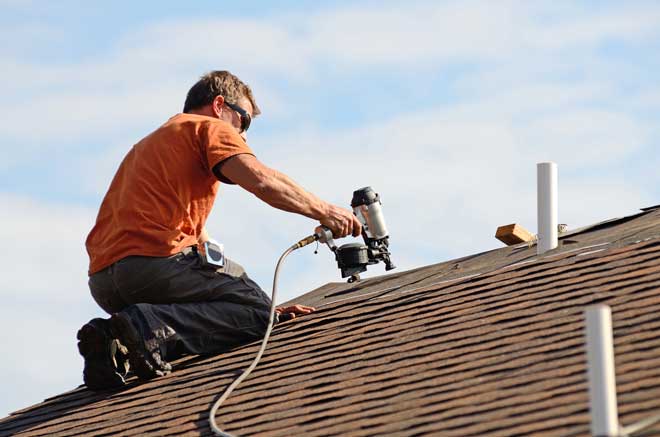When you install a new roof one of your main objectives is most likely to protect and maximize the life of your roof. To achieve that goal you need to carefully consider all the roofing materials you may use. Independent of whether you roof your home with steel roofing, cedar shingles, tile shingles or anything else, you should seriously think about using synthetic roofing underlayment to extend the life of your roof.
Synthetic roofing underlayment
The advantages of using and the benefits from synthetic roofing underlayment are numerous. For ease of installation in windy conditions this type of underlayment resists ripping and tearing far better than traditional felt roofing underlayment. In some cases synthetic underlayment is as much as 20 times more tear resistant than traditional felt.
Another clear advantage to using the synthetic underlayment as opposed to felt is that it easily lays flat without wrinkles. In contrast, felt tends to curl and wrinkle, making the roofing process more cumbersome. Working with synthetic underlayment is simply faster and far more efficient.
In addition, felt tends to stick to metal roofing and steel roofing. With synthetic roofing underlayment you don’t have that problem. With excessive heat or moisture the felt material adheres far too easily to metal and steel.
For safety during installation the synthetic underlayment can’t be beat. Its surface resists skidding and slipping, thus is easier to walk on. Felt on the other hand can become quite slippery when moist and will be potentially hazardous when walking on it.
For durability and integrity of material, synthetic roofing underlayment is clearly advantageous. The synthetic material will not absorb water. Felt is distinctly different and will easily absorb the water, causing a more rapid breakdown and weakening.
An additional advantage of the synthetic material as opposed to felt has to do with the potential erosion of the felt underlayment. Synthetic roofing underlayment is not subject to infestation or fungal rot. Felt, unfortunately, can be seriously damaged by insects. Furthermore, moisture and water absorption can lead to fungus with the felt surface.
More and more roofing contractors are switching to synthetic. For ease of use, safety during installation and ultimate roofing protection, synthetic underlayment is becoming the preferred choice. Whether you do it yourself or pay for the work to be done by a professional, you would be wise to choose synthetic roofing underlayment for your roof.
According to TheHomeDweller.com, metal roofing and underlayment have become increasingly popular as a roofing material for homes, businesses, barns, and other agricultural buildings. More and more people are installing metal roofing in areas where the weather tends to be more severe, from Indianapolis, IN to St. Paul, MN to Buffalo, NY, for example. The roofing panels can vary in length and width depending on manufacturer, but their large size allows for quick and easy installation.
Installing Metal Roofing
For installing metal roofing you should follow the manufacturer’s guidelines. However there are some basic tips you should always keep in mind. Minimum roof pitch, roof and trim application and trimming and cutting are just a few of the categories you should pay close attention to.
The roof pitch should probably be at least 2/12 (two inches of rise for every 12 inches of horizontal run) to consider using metal roofing. For all roof pitches less than 4/12 you should use both lap screws and sealant to the lap of each panel. The lap is simply the portion of the panel that overlaps the adjacent panel. This is recommended to insure that water flows down and off the roof and does not seep under the panels.
Installing metal roofing should always begin at the gable end of the roof that is on the opposite side of where wind driven rain normally hits your home. By adhering to this rule there is less likelihood that rain will find its way under the laps. The overlapped portion will be protected in this manner.
The exact placement of the first panel is crucial as well. Its edges should be square to the ridge and the eave so that the subsequent panels will follow a straight line along both the ridge and the eave.
You should also make sure that when you are in the midst of installing metal roofing, you create a slight overhang beyond the eaves so that water drips off the edge of the roof and not onto the building itself. If your building has gutters, this overhang can be as little as one inch. Otherwise, the overhang should be two to three inches in length.
Special tools like hand shears or nibblers are generally recommended to cut the metal panels. Shears are generally the safest because nibblers and saws might burn the painted surface of the panels. After cutting, regardless of the tools you use, be sure to brush off all particles so as to avoid future rust stains.
Don’t skimp on roofing supplies either. Though metal roofing is different from corrugated fiberglass roofing, cedar shingles, asphalt shingles and the like, the same basic rules of good workmanship apply. Installing metal roofing should be done patiently and methodically so that your building is not only attractive, but thoroughly protected.











